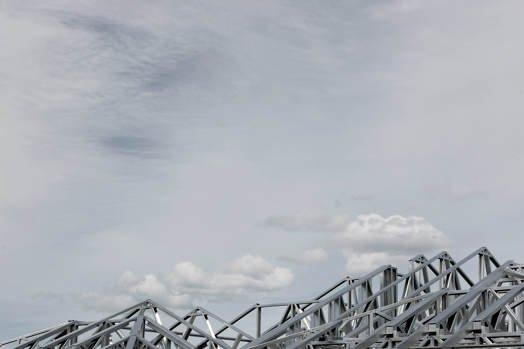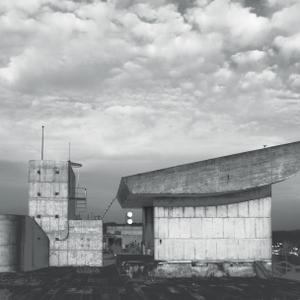The Death and Life of Great American Cities has been doing the rounds in Christchurch of late, in physical form and social media. It’s a 1961 book by urban studies activist Jane Jacobs, strongly condemning a certain 1950s brand of resource-hungry and "rationalist" urban planning.
Jane was in the room, metaphorically, as the images of newly approved suburban greenfield construction sites unfolded in Gavin Hipkins’ new and timely 12-minute video work, The Quarry, on display at The Physics Room. History proved these 1950s-style developments—uniformity, and the near-complete segregation of residential from commercial and industrial activity—to be problematic at best. But they at least had a historical context to sustain them: a big post-war economic boom, no lack of cheap fuel to power the daily commute and a strong associated ideology that owning lots of stuff is admirable.
At a time of global financial crisis and peak oil, adhering to this ideology and its associated planning policies is potentially calamitous, and definitely ignorant. The Quarry brings home—gently—the outrageous construction projects underway right now in outer Christchurch for those of us who only venture to the gated community of Pegasus Town or Wigram Park in our nightmares, or in the pages of The Press.
That’s not to say this work is "about" such developments. They’re there, empty lots and unclad timber frames, flowing past, along with images of water, clouds, stone, vegetation, a few stragglers running in the park… Hipkins intermittently shows us impressions of both unspoilt and cultivated nature, the southern Alps and the bright floral plantings of the Botanic Gardens, whose intensity of colour make the rest of the video deliberately drab. One shot halfway through the work is distinctive: an image of a mountain peak tackily treated in post-production with a digital mirror filter. Nature rendered uncanny (and tawdry) through artifice. The subsequent image, an unfiltered but equally symmetrical framing of a suburban cul-de-sac, is similarly artificial and uncanny, made more so by the juxtaposition. Both show (we interpret) aesthetic debasement.
Jane Jacobs was on my mind, but it was Victorian art critic John Ruskin in my ears. Or rather, it was his words—musings on the principles of good design and aesthetics—being read out in a slightly childish and disengaged sing-song female voice. The text (I’m told) comes from Ruskin’s 1850s The Stones of Venice, a work that reflected upon Venetian art and architecture to mount a warning about the decline of contemporary England due to a waning of Christian faith. The chosen excerpts, and delivery, sound like a somewhat archaic "how to" design manual. At times the visuals clearly illustrate the text; or is it the other way around? Other times they happily diverge, leaving the viewer/hearer to follow one train of thought or the other (yes, the images are themselves a train of thought) and work to synthesise them.
The Quarry (2013) Gavin Hipkins
There are obvious formal parallels to Patrick Keiller’s fabulous London (1994), a visual dérive through the city and its surrounds with an unseen and unnamed storyteller recounting the thoughts and exploits of himself and his also unseen friend Robinson. The surveillance-like images and first-person narrative of the adventures of two highly-educated English "queers" combine to mount a scathing and rather charming critique of Thatcher-era London. In choosing manual-like excerpts and delivery of Ruskin’s text for his narration, Hipkins lacks the engaging storytelling that sustains interest in London, at least for those (as myself) more accustomed to narrative feature films than gallery installations. The lack of characters and story also makes Hipkins’ critique less harsh, more reliant on viewers’ inferences.
The Quarry, though much shorter than London, requires more effort, or more easily becomes an absorbing wash of sound and images rather than a rational struggle to synthesise the two in meaning. Perhaps the effect—swinging the viewer from active interpreter to passive observer and back again—is intentional, but the moments that stuck out for me were ones of rational engagement (like the juxtaposition of symmetries above). At one point, The Quarry’s voiceover is advocating for a design approach that yields "unexpected arrangements" as we view magpies fossick on a pile of dirt in an unfinished residential development of boring repetition—the magpies’ behaviour the only possible unexpected element.
It’s particularly apt for a Christchurch work—and no accident, I assume—that Ruskin was a great advocate of Gothic Revival architecture, which he admired for (among other things) its rejection of mechanisation—symbolised in The Quarry via the dormant machinery visible on the construction sites. For Ruskin, creating Gothic architecture involved the whole community, and expressed the full range of human emotions, from the sublime verticality of the style’s arches and spires to the humour and playfulness of the carved grotesques. This side of present-day Christchurch—represented perhaps in the Romantic valorisation of intricate labour implicit in pleas to restore Christchurch Cathedral and, in different form, in the many unplanned community interventions and post-quake outbursts of civic play—emerge only by inference and absence.
An "expression of the artisan’s joy in free, creative work" is how Ruskin describes Gothic ornamentation, the carved stone (anti-capitalist) fulfilment of workers able to convey their own artistic ideas using their hands. We see no such ideals in The Quarry, a notable absence of any creative handiwork within the film, and the only stone the "negatively" machine-carved walls of the titular quarry, framed and presented such that you can’t tell which way is up.
It’s rich terrain to explore—Ruskin, Gothic Revival, mechanisation and the present state of Christchurch—though little of this present exploration was provoked by the video work itself, but rather by my own current interests and a writing assignment. It’s a work, driven by subtlety and inference, to which you the viewer have to bring a lot—and what you extract from this quarry depends very much on the labour you put into it.

